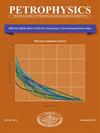钾肥鉴定(PID)图:一种用于商品钾肥鉴别的快速筛选交叉图
IF 0.7
4区 工程技术
Q3 ENGINEERING, PETROLEUM
引用次数: 0
摘要
钾盐矿物是钾(K)的主要来源,钾被用于制造火药、化肥和作为钠调味的替代品。商业碳酸钾矿物都是蒸发物。由于钾-40 (40K)具有放射性(衰变为氩-40 (40Ar),并在此过程中释放出伽马射线(GR)),当穿过蒸发岩序列钻探的油井中的GR (γ射线)测井曲线“偏离规模”时,通常会发现商业钾肥矿化。然而,并不是所有的钾肥矿物都可以通过地下开采技术成为钾的商业来源,钾也不是唯一的放射性元素。例如,新墨西哥州东南部Salado组的McNutt“钾肥”成员的矿物学非常复杂,由6种低品位(放射性)钾肥矿物组成的多个薄层(即厚度小于10英尺)组成,其中只有两种可用于商业地下开采。还有四种非放射性蒸发岩矿物,其中一种可能会干扰钾研磨化学和许多粘土岩和标志层(页岩和/或火山岩),其GR计数率与该层序中的低品位钾矿化相当。由于这种复杂性,传统的井眼电缆(WL)和随钻测井(LWD)钾盐分析技术,如GR测井-岩心分析转换,可能不足以识别新墨西哥州南部潜在的商业地下开采钾盐矿化(Teufel, 2008)。Crain和Anderson(1966)以及Hill(2019)分别开发了线性规划和多矿物分析,以从多个钻孔地球物理测量中估计钾盐矿物学和品位。然而,这两种方法都需要大量的多个日志测量。在新墨西哥州东南部,用空气钻穿Salado地层蒸发岩(包括McNutt“potash”成员)的油井,然后在不进行WL测量的情况下将套管和胶结到位。然后,使用水基泥浆将这些井钻至沉积物的总深度(TD)。完整的测井套件从TD到套管鞋,仅通过套管蒸发岩层序记录GR和中子测井,以进行地层和构造对比。因此,新墨西哥州东南部最近所有的油气井基本上都通过Salado蒸发岩进行了套管井伽马射线和中子测井。Hill和Crain(2020)开发了一个简单的交叉图,仅涉及GR和中子测井数据,可以区分无水和水合钾蒸发岩矿物。如果使用得当,这些井的测井数据可以提供一个快速的钾肥筛选数据库。该技术可用于裸眼和套管井测井,以及岩心测井,并可用于区分商业钾盐矿化与非商业(钾盐和非钾盐)放射性矿化。描述了在密歇根州、新斯科舍省、萨斯喀彻温省和新墨西哥东南部的蒸发岩盆地使用PID交叉图的案例历史。这项技术也可用于筛选世界其他地方潜在的钾肥矿床。本文章由计算机程序翻译,如有差异,请以英文原文为准。
The Potash Identification (PID) Plot: A Rapid Screening Crossplot for Discrimination of Commercial Potash
Potash minerals are the primary source of potassium (K), which is used for the manufacture of gunpowder, fertilizer, and as a sodium-seasoning substitute. Commercial potash minerals are all evaporites. Because potassium-40 (40K) is radioactive (decaying to argon-40 (40Ar) and releasing a gamma ray (GR) in the process), commercial potash mineralization is often discovered when GR (γ ray) logs in petroleum wells drilled through evaporite sequences “go off scale.” However, not all potash minerals may be commercial sources of potassium via underground mining techniques, and potassium is not the only radioactive element. For example, the mineralogy of the McNutt “potash” Member of the Salado Formation in southeast (SE) New Mexico is extremely complex, consisting of multiple thin (i.e., less than 10 ft thick) beds of six low-grade (radioactive) potash minerals, only two of which are commercial for underground mining. There are also four nonradioactive evaporite minerals, one of which may interfere with potash milling chemistry and numerous claystones and marker beds (shales and/or volcanics), with GR count rates comparable to the low-grade potash mineralization in this sequence. Because of this complexity, traditional borehole wireline (WL) and logging-while-drilling (LWD) potash assay techniques, such as GR log-to-core assay transforms, may not be sufficient to identify potentially commercial potash mineralization for underground mining (Teufel, 2008) in SE New Mexico. Crain and Anderson (1966) and Hill (2019) developed linear programming and multimineral analyses, respectively, to estimate potash mineralogy and grades from multiple borehole geophysical measurements. However, both of these approaches require large sets of multiple log measurements. In SE New Mexico, petroleum wells are drilled through the Salado Formation evaporite (including the McNutt “potash” Member) with air, then cased and cemented in place without running WL measurements. Then, the wells are drilled out to total depth (TD) in the underlying sediments with water-based mud. Complete log suites are run from TD to the casing shoe, with only the GR and neutron logs recorded through the cased evaporite sequence for stratigraphic and structural correlation. As a result, essentially all recent oil and gas wells in SE New Mexico have casedhole gamma ray and neutron logs through the Salado evaporite. Hill and Crain (2020) developed a simple crossplot involving only GR and neutron log data, which could discriminate between anhydrous and hydrated potassium evaporite minerals. Logs from these wells could provide a rapid potash screening database if used properly. This technique can be used with both openhole and casedhole petroleum well logs, as well as corehole WL logs, and provides discrimination of commercial potash mineralization from noncommercial (potash and non-potash) radioactive mineralization. Case histories of the use of PID crossplots in evaporite basins of Michigan, Nova Scotia, Saskatchewan, and SE New Mexico are described. This technique may also be useful in screening potential potash deposits elsewhere in the world.
求助全文
通过发布文献求助,成功后即可免费获取论文全文。
去求助
来源期刊

Petrophysics
地学-地球化学与地球物理
CiteScore
1.80
自引率
11.10%
发文量
40
审稿时长
>12 weeks
期刊介绍:
Petrophysics contains original contributions on theoretical and applied aspects of formation evaluation, including both open hole and cased hole well logging, core analysis and formation testing.
 求助内容:
求助内容: 应助结果提醒方式:
应助结果提醒方式:


